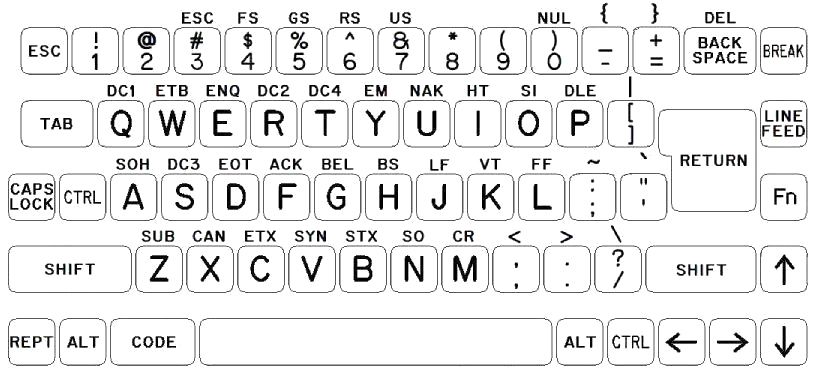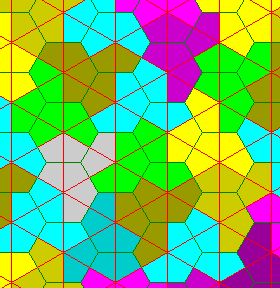
This is a list of a few of the most major sections of this site:
Finally, I have added to this site a page concerning one of the most popular mathematical subjects:
I had long delayed doing so, despite the topic being a natural for this page, as there are many other excellent pages on this subject on the Web. At present, it is quite a modest page on the subject, and I do expect to expand it.
I have now come up with a solution for what computer keyboards should look like, in order to facilitate touch-typing, and to be compatible with the typewriter-pairing APL/ASCII standard:

(Of course, for compatibility with the APL/ASCII standard, the characters < and > would need to be switched to being accessed in the conventional manner, with SHIFT, rather than with CTRL, as shown here.)
The page about Aperiodic Tilings Within Conventional Lattices has been updated with the addition of the news that an aperiodic tiling of the plane by just one tile has now been discovered! An image of part of this tiling is shown below:

A further update to this page has been made, concerning the revised tiling, involving a new shape called the Spectre, which constitutes a tiling based on a true aperiodic monotile, as the previous one required both the shape called the Hat and its reflection.
Back again, after a long absence:
One way to reduce the extent to which a map of the world shows obvious distortion is to interrupt the projection, so that the map is actually only showing a smaller piece of the world on a single projection.
In thinking of how to have a map that closely matches the globe while minimizing interruptions, I came up with this:
Instead of being interrupted in the ordinary sense, it is simply divided into two maps using the traditional division of the globe into the Eastern Hemisphere and the Western Hemisphere.
But to allow larger areas of each hemisphere to have low distortion, each hemisphere is depicted on a transverse conic conformal projection, the poles being on the Equator at 110° W and 70° E longitude.
The projection is conformal, so the shape of small areas is correct everywhere.
Distortion of areas is kept to a lower extent, though, than even in a Stereographic projection of both hemispheres, let alone that found in the Mercator or the Eisenlohr.
But it does have drawbacks.
Due to rapid changes in scale, Mexico, India, and Greenland, at least, are distorted in overall shape.
As with the Mercator, being conformal makes the projection pleasing, but this pleasing appearance is also potentially deceptive; if the map becomes commonly used, the shapes on the map might be taken as the "real" shapes of the world's countries. (Of course, the distortion is kept low enough for most places that the shapes on the map at least come close to the real shape of most areas.)
The map is inefficient in its use of space. This could be countered, in the version as illustrated, by chopping off the wing to the left with much of the Pacific Ocean, and making use of the extra space for supplementary information.
But the most serious problem with this projection, and the one most likely to prevent its widespread adoption, is that large areas of the map are inconvenient to read because they don't have North at the top.
Thus, instead of being used for large wall maps in classrooms, perhaps the best I could hope for is that it might be found useful for index maps in atlases.
Having recently added to this site the score of the Checkers game between James Wyllie and Robert Martins which was repeated, move for move, in 21 out of the 40 games of the World Championship match between them in 1863, it has occurred to me that I should call attention to a page on my site which proposes a way to solve the (fortunately less severe) problems which are faced by the game of Chess.
In Japan, the legendary Go player Honinbo Shusaku revolutionized the understanding of the game and improved the standard of play. The result of this, however, was not entirely fortunate. It became possible, with sound defensive play, for the first player (in Go, the one who sets down the black stones) to win almost every game by a margin of two or three points of territory.
This was dealt with by an innovation known as komidashi, in which Black is required to cover more territory than white by a margin which was at first 3 1/2 points, but which has since gradually increased to as much as 6 1/2 points, in order to be the winner, with White winning otherwise.
Similarly, in Chess, Wilhelm Steinitz revolutionized the understanding of the game, but this led to a situation in which sound defensive play, leading to draws, replaced exciting but unsound sacrificial combinations as the norm. In Chess, however, checkmate either takes place or it does not. One scheme that has recently become popular is to award only 1/3 point to each player in the case of a draw. While this scheme is effective in tournament play, I feel it is much less likely to be effective in match play; and it is, of course, the World Championship match in Chess which is the one Chess competition with the most chance of capturing the interest and attention of the general public.
On the page about Dynamic Scoring, I suggest a way to adapt the principle of komidashi to Chess.
If a player inflicting stalemate received 3/5 of a point, and the stalemated player 2/5 of a point, since the difference between the two scores is now 1/5 of a point instead of 1 point as it would be in the event of checkmate, allowing this lesser victory to be counted towards the result of a match would not destroy the parts of existing endgame theory which are concerned with avoiding a stalemate when a checkmate is possible. In Dynamic Scoring, I propose adding stalemate, bare King, and even perpetual check as minor victories, but with the points awarded for each minor victory more strongly favoring Black (the second player in Chess, of course) as the victory becomes more minor. The intent is to encourage Black to play somewhat aggressively instead of entirely defensively by favoring the Black side for minor victories, and in turn to encourage White as well to play aggressively instead of defensively, as the greater the victory, the less the amount by which the scoring scheme favors Black,
Also for quicker loading, a page about What's New on the site, but from which I haven't had the heart to remove links to some of the older new things from, is on a separate page.
I will keep one highlight from the site on the front page, however:
this heptagonal tiling is from a section of the web site that discusses such matters as Penrose tilings.
Other attractive images on my site include one of the Riemann Zeta Function, what I think is a very nice map on the world based on Lambert's Conic Conformal Projection, a really colorful series of pages with drawings of computer front panels (of course, if you use Google, you can find actual *photographs* of nearly all the computers presented).
It's difficult to summarize the content of this site, but in addition to the major sections on cryptography and map projections listed above, mathematics, board games, and computers are addressed here.
These pages now include advertisements. These advertisements make use of a cookie to serve advertisements based on your interests. You may disable this by visiting this web page.